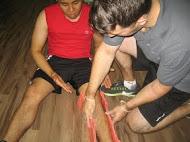Creating a splint provides a lot of relief to an injured person and control further injuries. Just as it is with other things there are the right and wrong techniques of applying a splint to an injured person. To ensure efficiency it is important to avoid the following mistakes.
Do not Splint the Limb Very Tightly

Splinting should provide the required support and reduce the movement. However, it should not reduce the movement to an extent where it prevents effective circulation of blood. It should give some allowance for you to put fingers between it and the broken limb. It is also important look at the pulse of the opposite side of the splint. It must be strong just the way it happens on non splinted limb. When creating a splint, you can also look at the capillary refill where you do some squeezing of the toe nail or finger nail for some few seconds to ensure it is white. Then, you are supposed to release it to check the speed at which the color returns to the squeezed nails. If there is normal blood flow the color should return within two to three seconds. Always check for any swelling, because the splint may affect the circulation of blood as a result of the swelling.
Avoid Creating a Splint that is Impenetrable
A good splint should be removed easily to ensure effective checking of the wounds. This will also allow you to give allowance for swelling by making adjustment of the wrappings and splint tightness. Ensure the knots are tied where they can be accessed and can be untied easily later. Do not use duct tape in splinting.
Don not Make a Splint that is too Small
Creating a splint that is too small may not give the support and flexibility required. The general rule is to ensure that the two adjacent joints are immobilized. For instance, for a splinted elbow, both the shoulder and the wrist must be immobilized. This will ensure that there is less movement of the injured part for it to be protected.
Using less padding
When creating a splint, you should use a lot of padding. Use materials that are soft that will ensure the limb is padded before the splint is put on. Make sure that any hollow spaces between the padding are filled to support the whole area effectively. This will ensure that the limb is well supported and avoid more damage.
[youtube url=”https://www.youtube.com/watch?v=eSSw8Db0BrU” width=”200″ height=”200″]